Church of MO: 2008 Triumph Tiger
Ten years ago, the Tiger was already 15 years old, making the one we just tested in our massive ADV comparison, let’s see, ahhhh, a quarter-century old. Old as Methuselah. Alas, we’ve come a long way in that decade. A reading from the book of Pete.
2008 Triumph Tiger Review
Tame but not timid
The Tiger model name has been in Triumph’s line-up on and off since the mid-1930s. In pre-WWII era, Tiger models were all parallel Twins, as at the time the now-famous in-line Triple that powers many Triumph models didn’t exist. The Tiger we know today will soon turn 16 years old, and though not related to those very early machines, it has a history of its own. Before the ’09 model sneaks up on us, we’ll take a quick look at the 2008 Tiger.Timeline of a Tiger
In 1993 the first in-line three-cylinder Tiger was born with an adventurous attitude. Looking similar to those motorcycles that streaked across the nearly intolerable landscapes that made up Paris-Dakar, the Tiger had an eye toward adventure-style riding with its 885cc Triple and upright riding position. Also note, since this was in a time before fuel-injected motorcycles would be produced in large numbers, the Tiger was carbureted. Remember carbs?
Rarely will a manufacturer tout plainly the off-road or near off-road capabilities of a bike that is also designed to see most of its travels on pavement, but like BMW’s world-traversing boxer-Twin GS, Triumph’s implications were clear. The Tiger rolled on spoke wheels, with a 19-inch hoop up front carving the way, leading many riders to refer to it as a “big trailie.”
The big cat got a big change in 2001, receiving the much more potent, and now fuel-injected, 955i Triple that supplied some additional 20 horsepower (claimed 104bhp @ 9500rpm). Carrying the new engine was an all-new chassis, and suspension upgrades in ’02 that favored more urban jungle environments rather than the Serengeti were complemented by the addition of cast-aluminum wheels in 2004.
A new breed
A successful company doesn’t stay in business as long as Triumph has by resting on its laurels, and for 2007 the Hinckley, England-based company kicked the Tiger in the tail, rousing it from a midday nap in the shade. This latest iteration of the big cat is now powered by the mighty 1,050cc Triple, though retuned for torque, as is found in Triumph’s iconic hooligan. The bottom-end-biased mill is carried in an aluminum beam perimeter frame as a stressed member while a braced aluminum swingarm rounds out the frame package.
One very notable change, along with the sharper, more aggressive styling, is wheel size. Triumph indicated the Tiger’s on-road commitment, eschewing the 19-inch front wheel in favor of 17-incher that now matches the 17 out back, opening the door for riders to fit modern sportbike rubber.
Suspension is the work of an inverted 43mm Showa fork adjustable for preload, and compression and rebound damping. A Showa shock allows for spring preload changes via a remote screw-type hydraulic adjuster, and also has a rebound damping adjustment.
The bike sits tall in the saddle at nearly 33 inches, but the dished out saddle is quite supple and makes long days on two wheels easy.
Since the Tiger is a cat, we can’t use the phrase “grab the bull by the horns” when telling you to get the bike under your control, so we’ll just have to tell you to grab the wide, rubber-mounted upright handlebars that allow for a good amount of steering leverage. Instruments snatched from the Daytona 675 are nestled behind the decent windscreen that offered good wind protection without generating unnecessary buffeting for the Motorcycle.com staffers that rode the bike. However, EIC Duke commented that the larger accessory windscreen he sampled earlier this year is even better.
Part of the Tiger’s service to us would entail a lengthy ride to Laguna Seca for the 2008 Red Bull U.S. MotoGP, so we opted for the available ABS on our test unit, as well as accessory hard sidecases and top trunk that doubles as a pillion backrest.
Though feel from the four-piston radial-mount Nissin brakes bordered on wooden at times as they pinched a pair of 320mm floating discs, there’s still plenty of stopping power from the very capable binders. Finding just the right spot (usually position 3) on the four-position adjustable brake lever helped alleviate some of the numb feel, and when ABS did activate, it did so unobtrusively.
‘This latest iteration of the big cat is now powered by the mighty 1,050cc Triple…’
ABS on the rear brake, on the other hand, was anything but transparent. A hefty stomp on the brake pedal resulted in some serious pulsing feedback from the brake, to the point that it really didn’t slow the bike very well. Good thing, like you, we almost always rely on the front brake.
Fotog Fonzie put in some generous miles on our Blazing Orange Tiger, making full use of the luggage. Unfortunately, he found the side bags to be smaller internally than what they appear, and all of the braided string lines, two per luggage, that keep the hinging half of the bags from falling open, snapped at the knotted end. It became rather tiresome to have to keep the luggage from flopping open like a dried-out clam, preventing us from using both hands to load or unload the bags. On an up note, despite the luggage’s latch system requiring a small learning curve, it’s nice to be able to use one key to operate the bike’s ignition, open the fuel tank, unlatch the saddle and secure or open the luggage. If nothing else, that’s one less key involved in scratching up the top of the triple clamp.
Heart of a lion
OK, you say, you can buy some more bailer’s twine to fix the saddlebags, and you never use the rear brake anyway, so what really matters is the legendary Triple power, and handling to match, ya? No doubt! Spitting the word Triumph out of your mouth usually results in the first thoughts of those around you going something like, “Mmm… Triple torque make me giddy. Triple sound make me dreamy. Mmm… Doughnuts!”
With basically the same powerhouse that propels the driver-license-eliminating Speed Triple to new heights of rider asininity, the Tiger, though it may crouch, is no slouch. The tuned-for-torque mill means levering the Tiger’s front-end off the ground with limited input from the right wrist is what I imagine take-off on a magic carpet must be like: feathery light. There’s no lack of twist from down low, as peak torque of 65.5 ft-lbs arrives very early at 3,500 rpm, carrying a dyno curve nearly as flat as what the Street Triple 675 produces. The Tiger’s max power is 101.5 hp at 9,200 rpm.
Considering dyno results of 110 hp at roughly 9,000 rpm and 69.5 ft-lbs at approximately 7,500 rpm for the Speed Triple 1050 as published in Motorcycle Consumer News, the Tiger’s state-of-tune is more than just a shadow of its naked brother, the Speed.
Roll-on power at freeway cruising speeds on the Big Cat is ample and eager; vibration from the engine was minimal. My only minor disappointment with mill was that it seemed to lack some of the grunty, rugged character of its naked siblings. But this may be more of an illusion, as what I might have perceived was a kinder, gentler song from the intake and exhaust. Eh, maybe my helmet’s too tight…
Fueling is decent most of the time but can be abrupt transitioning from closed to open throttle. This abruptness, however, was exacerbated by suspension that was way out of sorts when I first got my grubby little mitts on the Tiger. Thankfully, as noted, there are adjustments on both ends. But in fiddling with all points, I discovered that the range of adjustment for compression and rebound damping on the fork and rebound on the shock seems fairly limited with about two to three full turns between full Soft and full Hard. Spring preload on the shock and fork offer a more typical range of adjustment.
The shock seemed to either have far too light of spring rate, or was sacked out. I turned the shock’s remote hydraulic preload screw adjuster, located just behind the right footpeg guard, so that the collar that presses down on the spring was essentially all the way out, or down. Maxed out would be a simpler way of saying it. Preload on the fork seemed average: about 50 to 60% of available preload. Further tweaks of compression and rebound damping here and there eventually balanced the ride, eliminating pitching during heavy acceleration as well as quite a bit of front end dive.
Despite what seems like a limited range of suspension adjustments, we’d be remiss if we didn’t consider that the experienced Mr. Duke reminds us that not every competitor in this category of sporty tourers has so much suspension adjustment, like the venerable VFR from Honda, for example.
Prior to this brief tune to the suspenders handling was horrid, and I couldn’t fathom what might have been wrong. Initial turn-in effort required some serious oomph on the bars despite its sporting 23-degree rake. Regardless of the opening shove needed to get the bike carving, turning effort belied the bike’s 59-inch wheelbase and claimed 463 lbs claimed dry weight. However, getting the bike to track through a turn required constant pressure on the inside grip, making me think someone sneaked a big 19-inch front wheel mounted with an enduro tire back onto the Tiger when I wasn’t looking. I hadn’t experienced such crummy handling on a modern bike before. Thankfully, all was made well, as twiddling the suspension knobs resolved many of the ride quality issues. Also, the abrupt throttle response was significantly less obvious. I had tamed this Tiger into one well-behaving commuter/tourer/surprise canyon carver.
Bring a Tiger home?
This cat wasn’t without a couple unruly qualities, like the flimsy string in the hardcases, and the tired shock spring. But things like a single key to operate all locks, a good amount of cornering clearance, a roomy and comfortable rider triangle, an observed average of 39 mpg from the 5.2 gallon tank, and a large readout in the LCD for miles remaining before you’re walking, are the simple things that are often forgotten, but once remembered either mask-over or outshine any ticks in the Negative column.
Our own Fonz summed up his many miles in the Tiger’s saddle by saying the Tiger had become his “best friend, with just enough room to carry a couple bags of groceries or a weekend’s get-away kit, and way more top end from the engine” than he’d ever need.
With a non-ABS U.S. retail of $11,199 and $11,899 for ABS, the Tiger easily stalks the likes of Honda’s VFR, Buell’s Ulysses XB12X or XT, Ducati’s Multistrada, and even BMW’s base-model R1200GS. In fact, it may even make a meal out of a couple of them in terms of value.
If you’re in the market for such multi-purpose bikes, you’d be a well-informed consumer if you factor Triumph’s Tiger 1050 into the pride.
Rrrrr! (Done in a proper English accent, of course.)
| The Perfect Bike For… | ||
| Someone who wants a Swiss Army knife of a bike, but with an English quality in the form of a throaty, grunty in-line Triple. | ||
| Highs: | Sighs: | |
| 1,050cc Triumph in-line TripleRoomy, comfortable ergosUnique in the class | Slightly abrupt fuelingShock spring too light or too tiredClaw mark decals on the tank not back in vogue yet | |
More by John Burns



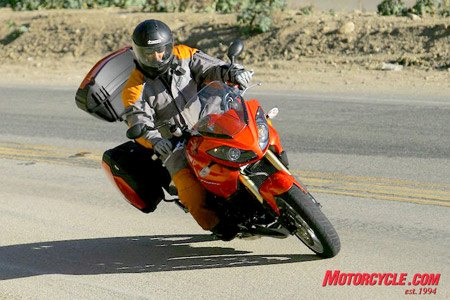











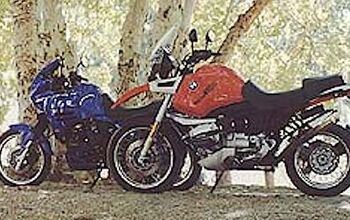

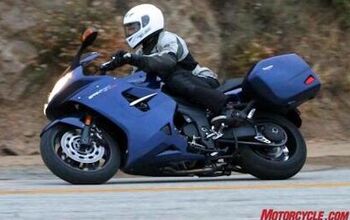
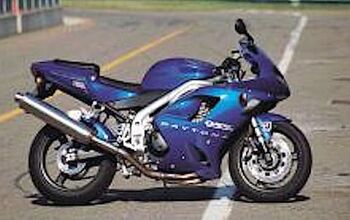











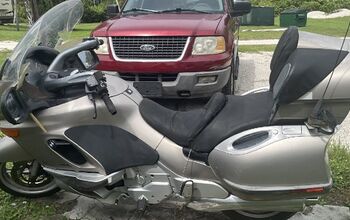


Comments
Join the conversation
Tigers are functional,with enough power, clear and informative instruments, decent ergonomics, and carrying capacities (when equipped with accessory panniers, etc). They sometimes feel a little bland, but if you twist the grip hard enough the resulting growling and snarling from the Triple will pump a little adrenalin.
I'm happy Triumph didn't chase ever increasing sport-touring power over the past decade and instead revamped the Tiger line back towards it's adv roots.